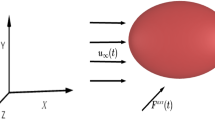Abstract.
Let \( \cal B \); be a homogeneous body of revolution around an axis a, with fore-and-aft symmetry. Typical examples are bodies of constant density having the shape of cylinders of circular cross-section, of prolate and oblate spheroids, etc. In this paper we prove that, provided a certain geometric condition is satisfied, the only possible orientations that \( \cal B \); can eventually achieve when dropped in a Navier-Stokes fluid under the action of the acceleration of gravity g and at a small and nonzero Reynolds number, is with a either parallel or perpendicular to g. This result is obtained by a rigorous calculation of the torque exerted by the fluid on the body. We also show that the above geometric condition is certainly satisfied if \( \cal B \); is a prolate spheroid. Moreover, in this case, we prove, by a "quasi-steady" argument, that, at first order in λ, the configuration with a perpendicular to g is stable to small disorientation, while the other is unstable, in accordance with experiments.
Similar content being viewed by others
Author information
Authors and Affiliations
Additional information
Accepted: January 19, 2001
Rights and permissions
About this article
Cite this article
Galdi, G., Vaidya, A. Translational Steady Fall of Symmetric Bodies in a Navier-Stokes Liquid, with Application to Particle Sedimentation. J. math. fluid mech. 3, 183–211 (2001). https://doi.org/10.1007/PL00000968
Issue Date:
DOI: https://doi.org/10.1007/PL00000968




